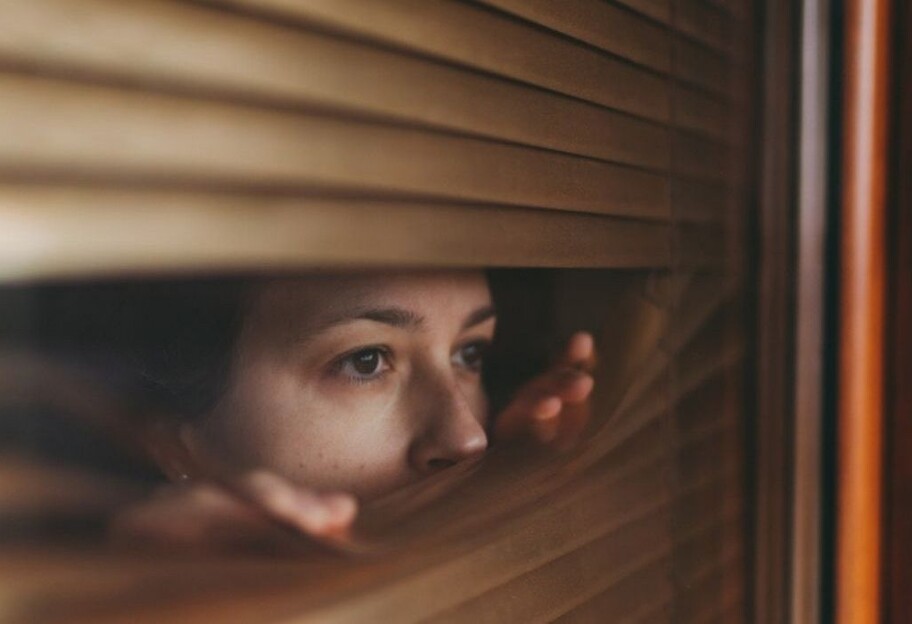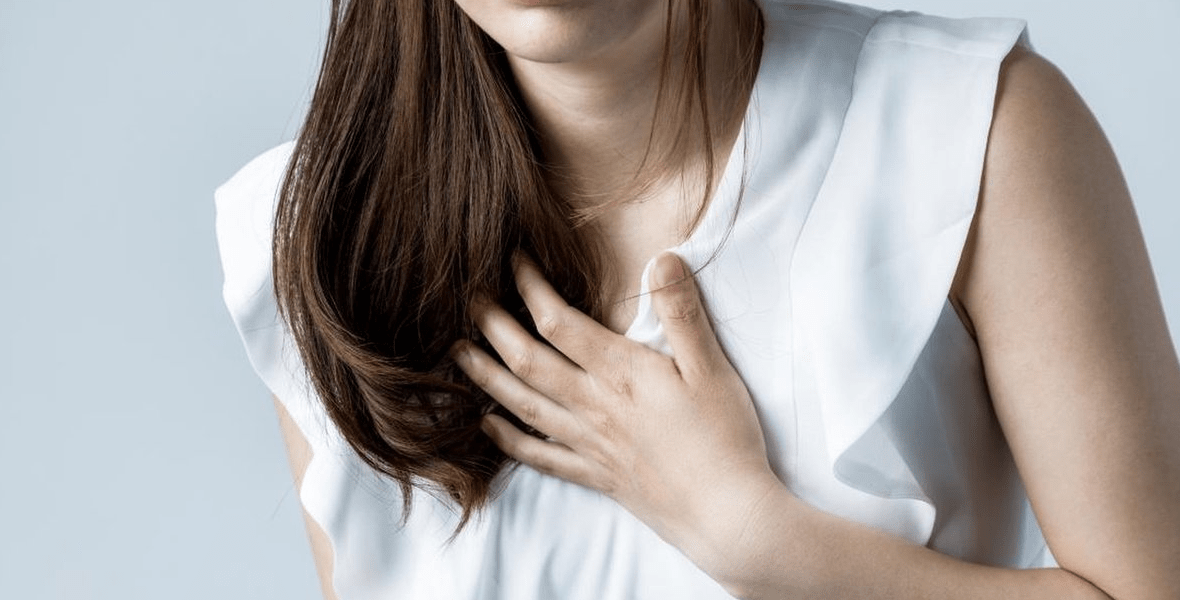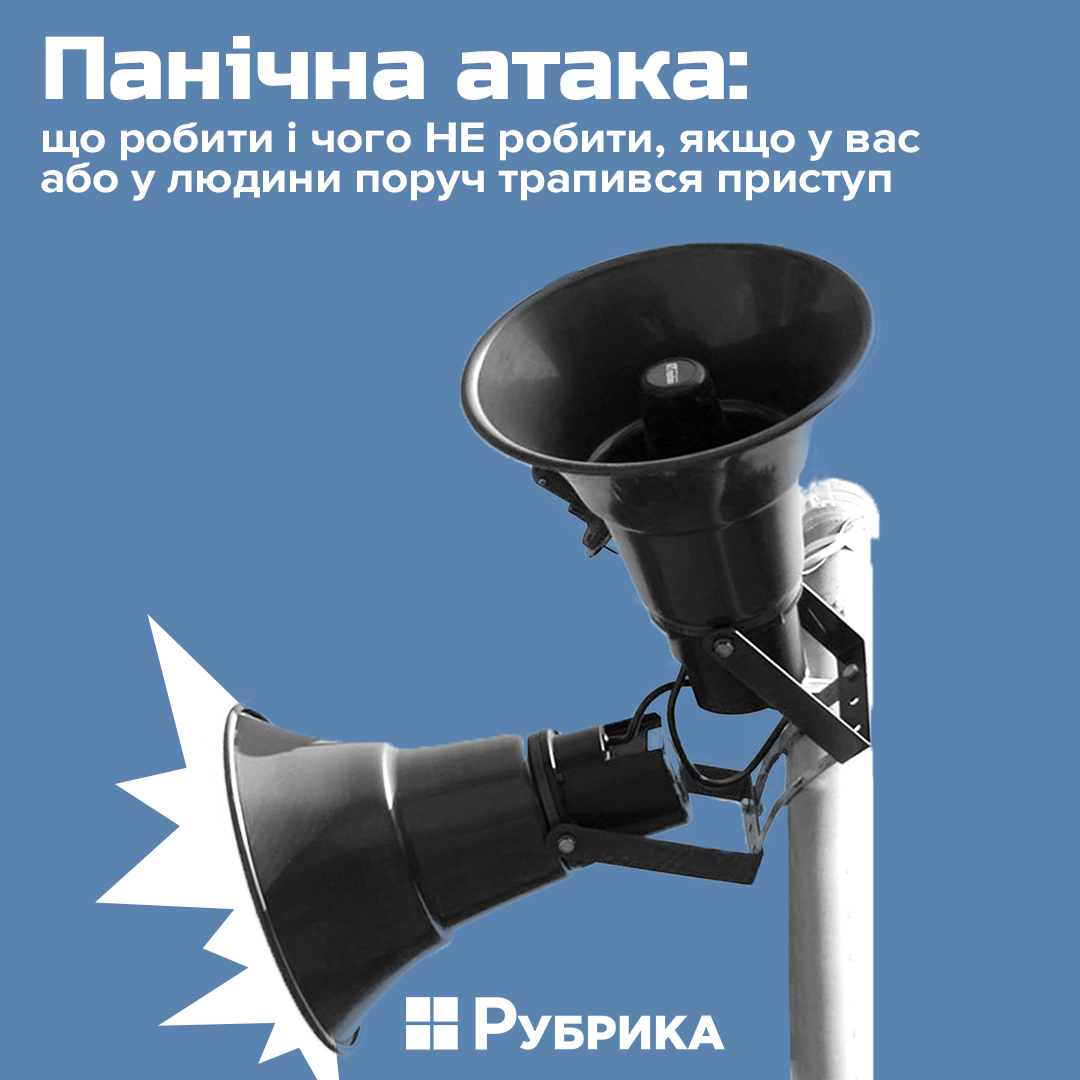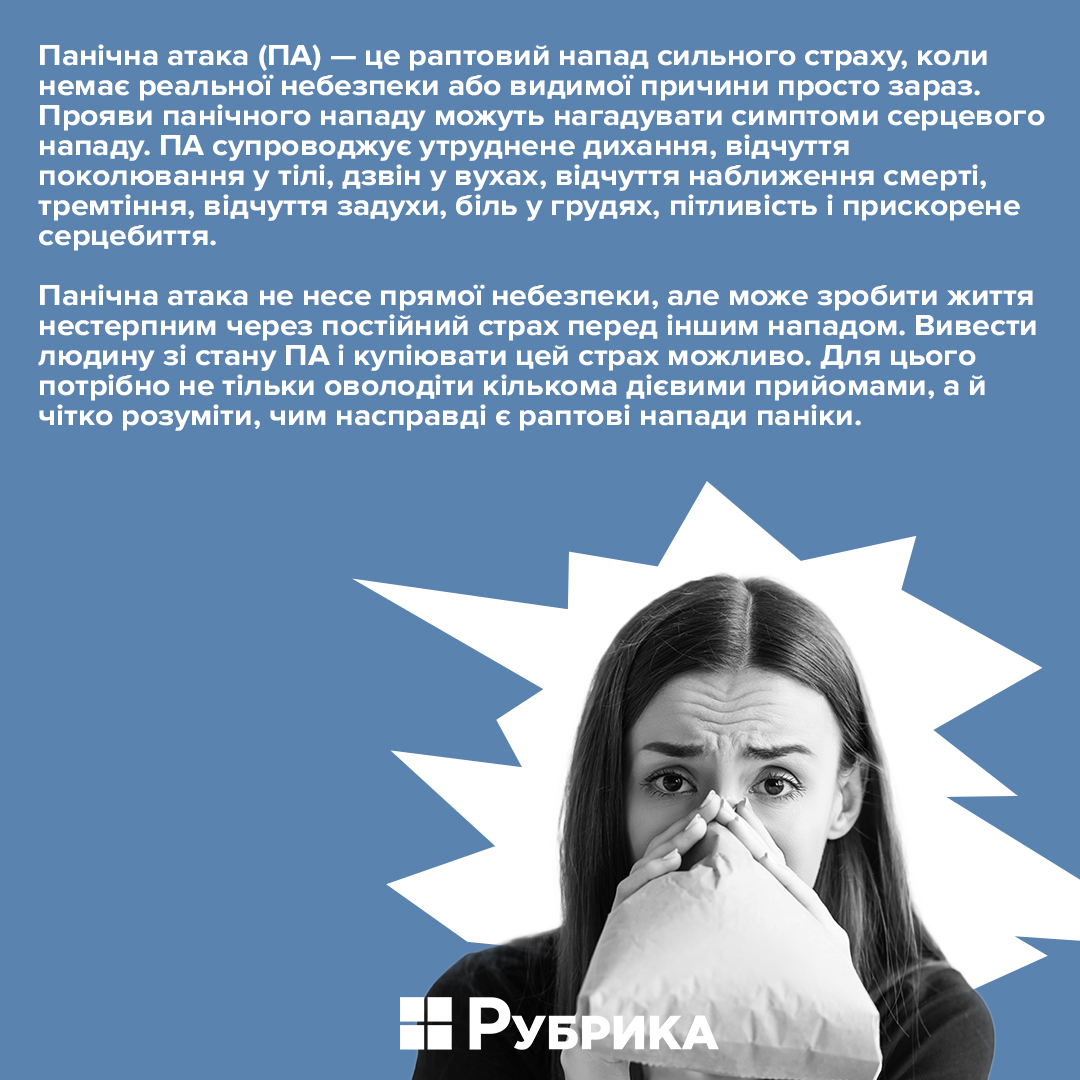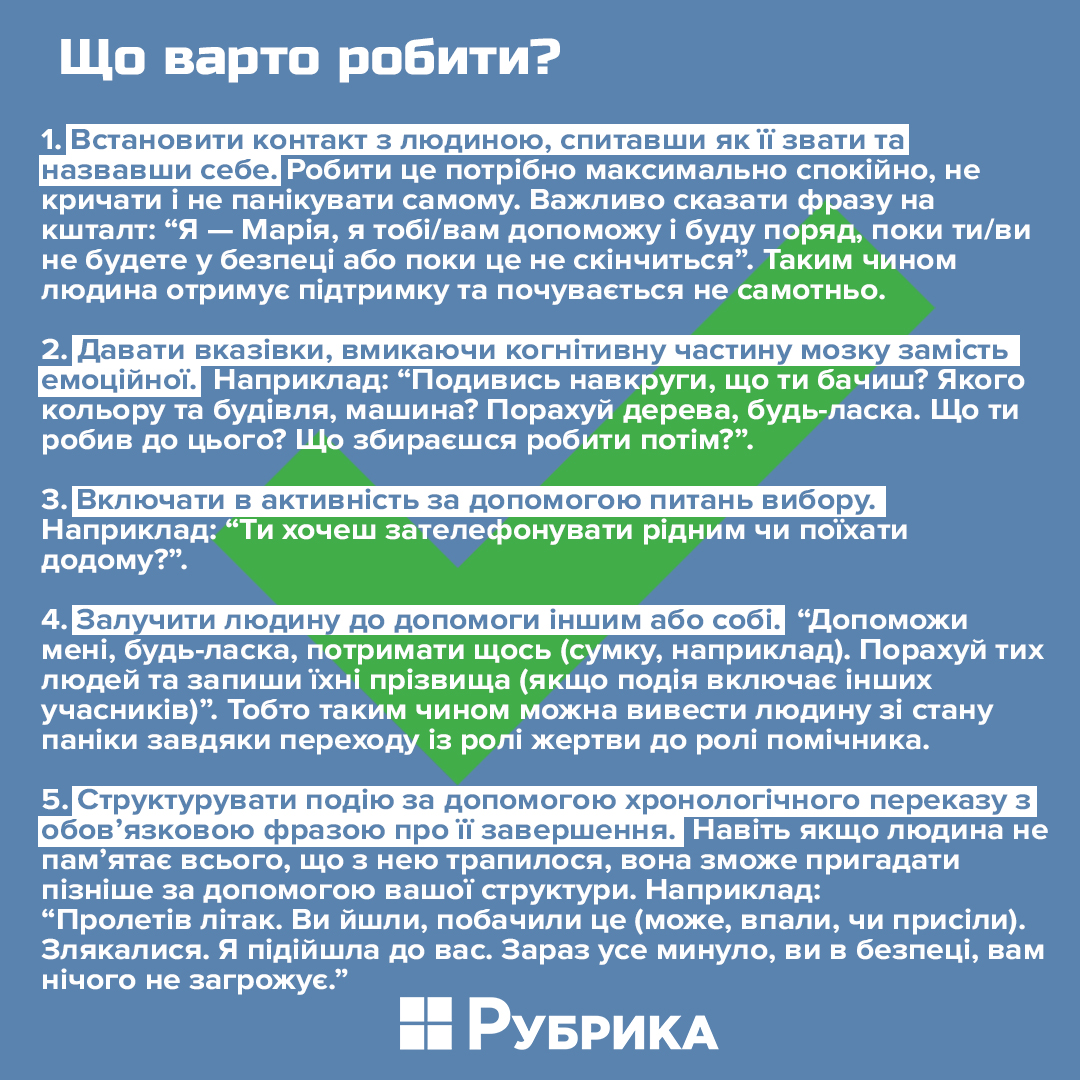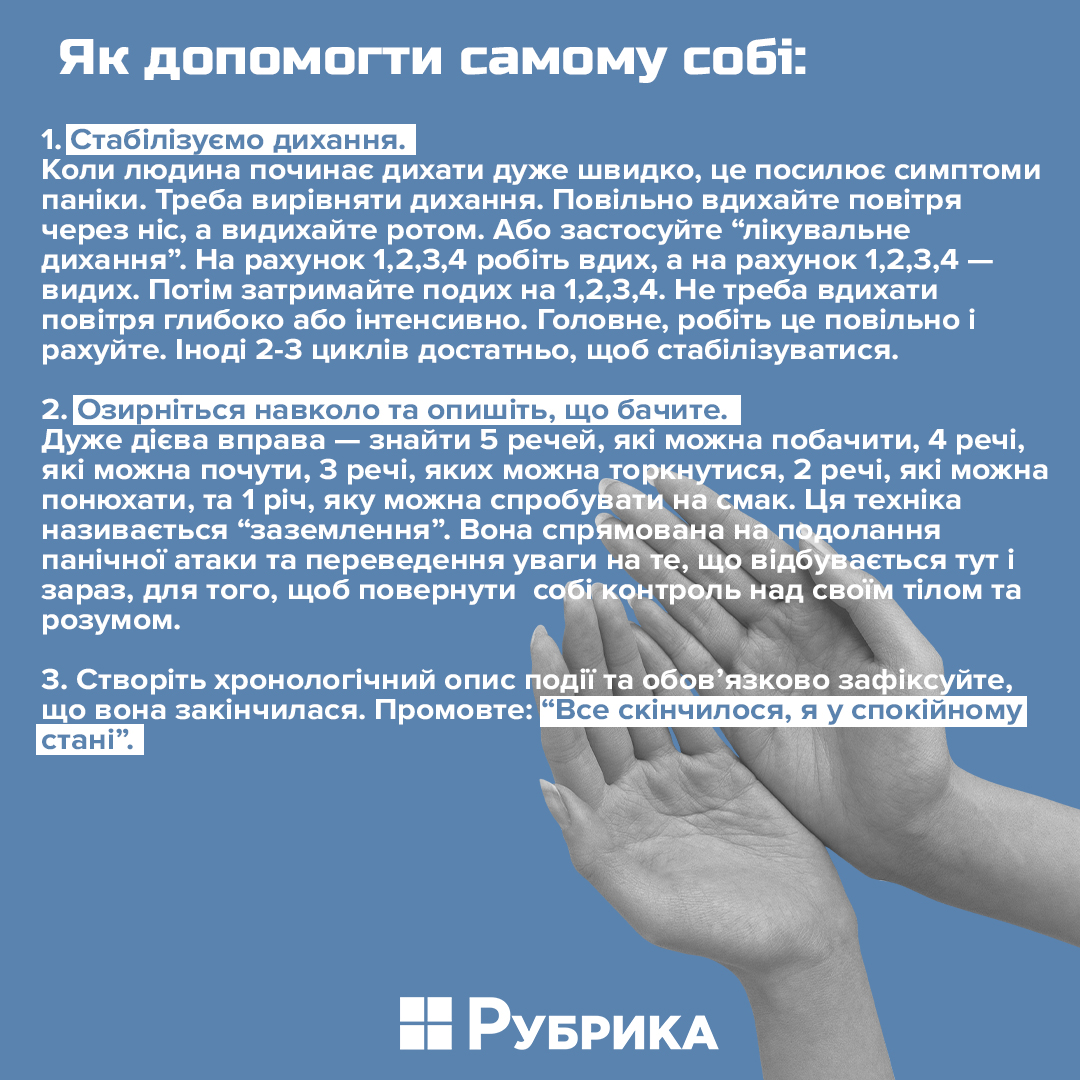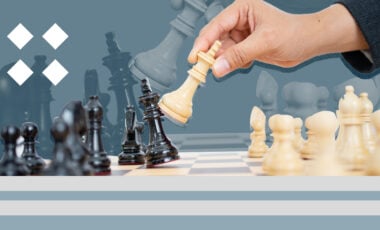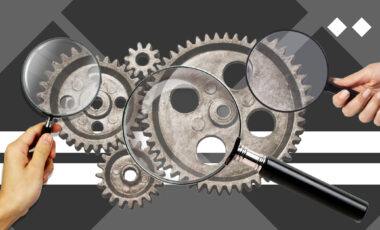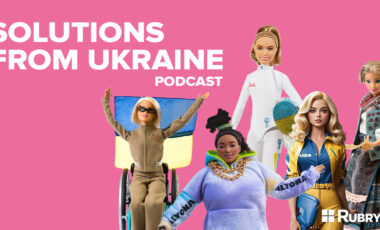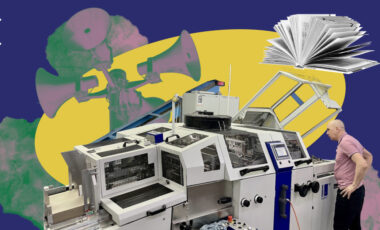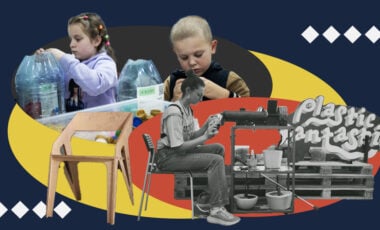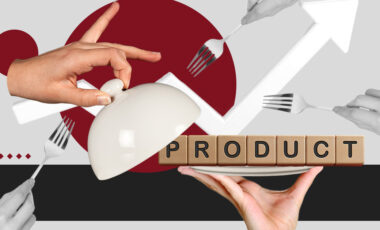Panic attack: what to do and what NOT to do if you or someone nearby is experiencing an episode
Hugs, a glass of water and an offer to sit down won't help. We explain why and what to do instead.
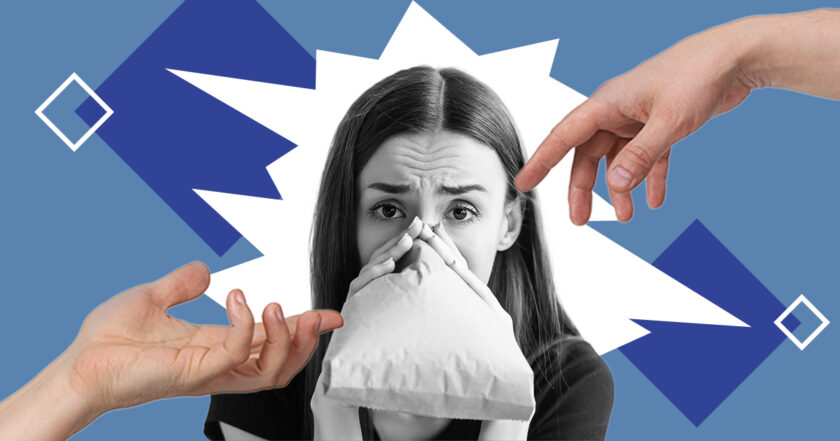
What is the problem?
In Ukraine, there are now even more people who have survived the horrors of war. They can be frightened by thoughts, memories, a shout on the street, or a car signal, even in a completely calm region of Ukraine. How to help such a person during a panic attack? How to make this condition end faster? How to calm down a person who experienced this just on the street, and how to "pull yourself together" when no one is around and you feel that a panic attack will happen to you right now? Rubryka talked about all this with psychologist and accredited Gestalt therapist Svitlana Morochkovska.
What is the solution?
A panic attack (PA) is a sudden attack of intense fear when there is no real danger or apparent cause just now. Manifestations of a panic attack can resemble the symptoms of a heart attack. PA is accompanied by difficulty breathing, a tingling sensation in the body, ringing in the ears, a feeling of approaching death, tremors, a feeling of suffocation, chest pain, sweating, and rapid heartbeat.
A panic attack is not directly dangerous, but it can make life unbearable because of the constant fear of another attack. It is possible to bring a person out of the state of PA and conquer this fear. For this, it is necessary to master several practical techniques and clearly understand what sudden panic attacks really are.
How does it work?
In "ordinary life," panic attacks are not always caused by stress. The experience of psychologists with panic attacks shows that behind them is the thought, "I can't handle it." That is, a person endures, endures, and when life throws up new difficulties, the brain says: "That's it, I'm giving up, it's too much, I can't do it…". Over time, fear of the PA's symptoms appears, and a person limits themself in order not to face them and is forced to avoid certain circumstances (public transport, queues, conflicts, etc.). It does not allow you to live everyday life.
Experts say that many emotions are packed into the PA. Often these emotions are "forbidden," so a person does not notice them. If they were aware of them and lived them, there would be no PA.
Therefore, it is worth working with a psychologist to observe one's anger, anxiety, guilt, shame, irritation, self-demands, confusion, sadness, pain, and disgust. It relieves tension from the brain and unloads the inner container. Thus, a person becomes more resistant to external pressure.
Since February 24, our lives have changed dramatically. A panic attack can happen to anyone, anywhere, and under any circumstances. Not everyone has the opportunity to study their condition with a psychologist carefully. Therefore, we currently need new knowledge and competencies in the field of psychological first aid.
Will it really work?
Svitlana Morochkovska claims that we can provide such help to other people or ourselves during any stressful situation. It is worth remembering that people who have experienced traumatic events related to the threat to life or violence can be more vulnerable, and their reactions become more acute. All receptors work in the "standby" mode and can be in this state for a very long time.
So what to do if a stress reaction occurs? The trigger event may not necessarily be a rocket, explosion, or siren. Anything can be a trigger — the roar of an airplane, the rumble of a car or thunder, the popping of a balloon — and a person reacts to it with a panic attack, shock, or stupor.
The feeling of helplessness aggravates the symptoms of the stress reaction. The opposite of helplessness is active action. Action can minimize the impact of a traumatic event on a person. It takes about one and a half minutes to transfer a person from a state of helplessness to a state of activity if you act according to a certain algorithm.
First, let's figure out what not to do.
What NOT to do:
❌ 1. Hug.
Yes, it sounds strange because the first intention of help is to hug and protect a person under stress. It is pretty natural, but it is inappropriate during an acutely stressful situation because a person's sense of helplessness and passivity only increases. And the state of regression prevents us from acting actively. This is especially important when the danger still exists, and you must act quickly to save yourself or your children. Instead of "I protect you," you should tell the person, "Protect yourself, take care of yourself."
Hugs are just as inappropriate as addressing a person as if they were a small child. For example, such appeals as "poor girl, kitty, bunny" will activate the center of emotions, the amygdala. It means that the center of decision-making and action, the prefrontal cortex, will function worse in such a case. In the competition "Amygdala VS Prefrontal cortex," the center of emotions wins. So, in stress, our emotional center reacts faster than the cognitive center. Therefore, it is essential to build communication with the victim based on cognitions, not emotions, in order to support the activity of the prefrontal cortex and restore the person's feeling that they are not a helpless little child but an adult and strong person who can act and protect themself in case of danger.
❌ 2. Offer to sit down.
On a physiological level, blood will flow to the legs during a stressful state, so sitting in such a state will definitely not be beneficial. Well-being will not improve, and the feeling of helplessness will increase on an emotional level.
❌ 3. Offer a person to drink some water.
A glass of water won't do any good unless it's a critical dehydration situation. This is a movie cliché, not a helpful action in an extreme situation. During swallowing, the parasympathetic nervous system responsible for relaxation will be stimulated instead of the sympathetic nervous system responsible for mobilizing the body. Hence, it will also increase a person's helplessness.
❌ 4. What else should not be done?
Two things. Isolate if there is no need for it and suggest forgetting about the terrible event and not thinking about it. The first does not bring any benefit, it only increases a person's feeling of loneliness, and the second is simply impossible.
What should be done?
✅ 1. Establish contact with a person by asking their name and introducing yourself.
You need to do this as calmly as possible, do not shout, and do not panic. It is important to say something like: "I am Maria, I will help you, and I will be by your side until you are safe or until it is over." In this way, a person receives support and feels not alone.
✅ 2. Give instructions, turning on the cognitive part of the brain instead of the emotional one.
For example: "Look around, what do you see? What color are the building and the car? Do you have a mobile phone? What is your phone number? Count the trees, please. What did you do before that? What are you going to do later?".
✅ 3. Include in the activity with the help of choice questions.
For example: "Do you want to call your relatives or go home?".
✅ 4. To involve a person in helping others or themself.
"Help me, please, to hold something (a bag, for example). Count those people and write down their names (if the event includes other participants)." That is, in this way, a person can be brought out of a state of panic thanks to the transition from the role of a victim to the role of a helper.
✅ 5. Structure the event using a chronological retelling with a mandatory phrase about its completion.
Even if a person does not remember everything that happened to them, they will be able to remember later with the help of your structure.
For example:
- A plane flew by.
- You were walking, you saw it (maybe you fell or squatted).
- You got scared.
- I approached you.
- Everything is over now, and you are safe, nothing is threatening you.
It should be done as emotionally detached as possible (only facts!) and concisely.
Structuring traumatic memories in the first 6 hours after the event is better. This period is also called the time window. Such completion is important prevention of PTSD and flashbacks. With children, the completion of the event can be done with the help of cards with pictures, which they draw and lay out with you in chronological order.
You can practice using this protocol with friends and family so that even when stressed, you can apply it when needed.
More useful solutions!
As for self-help, Svitlana Morochkovska reminds: remember that the state of a panic attack is very unpleasant but absolutely not life-threatening. Even if you feel like you are short of air, your heart is beating very fast, and your body is shaking, you will not die. It is not life-threatening; it is a temporary failure.
During a panic attack, the sympathetic nervous system is activated, and the parasympathetic, on the contrary, turns off. Everything that engages the cognitive part of the brain and physical practices works to restore balance. So understanding what is happening to you engages that part of the brain and begins to rebalance the nervous system.
What to do:
- Stabilize breathing.
When a person begins to breathe very quickly, it increases the symptoms of panic. You need to balance your breathing. Inhale slowly through your nose and exhale through your mouth. Or use "healing breath." Inhale on the count of 1,2,3,4, and exhale on the count of 1,2,3,4. Then hold your breath for 1,2,3,4. Do not inhale deeply or intensively. The main thing is to do it slowly and count. Sometimes 2-3 cycles are enough to stabilize.
- Look around and describe what you see.
A very useful exercise is to find 5 things you can see, 4 things you can hear, 3 things you can touch, 2 things you can smell, and 1 thing you can taste. This technique is called "grounding." It aims to overcome a panic attack and shift attention to what is happening here and now to regain control of your body and mind.
- Create a chronological description of the event, and be sure to record that it ended. Say: "It's over; I'm in a peaceful state."
None of us was ready for war. But we have no right to give up or be weak now. Our loved ones, relatives, and the country need us because each of us does a part of the work for a victorious and peaceful future. It will be physically and psychologically challenging, but we still must take steps to stay afloat in this whirlwind of events.
We will definitely return to our peaceful life, but today we must hold on and protect ourselves and our mental health. So we will win!


